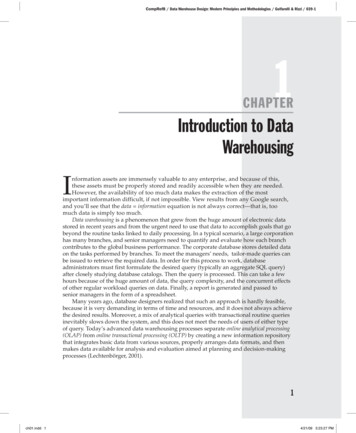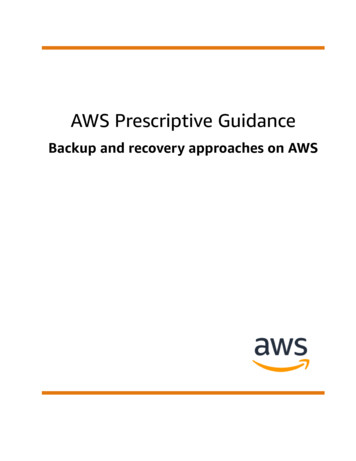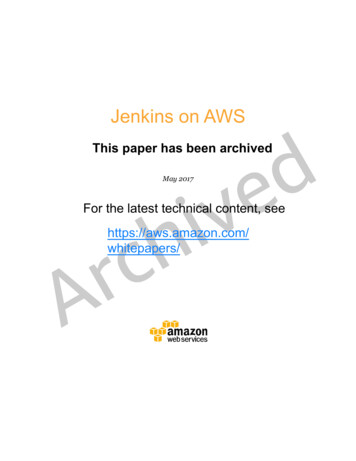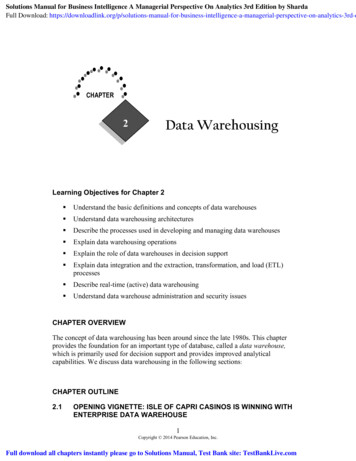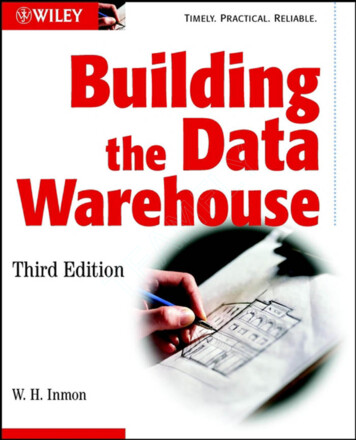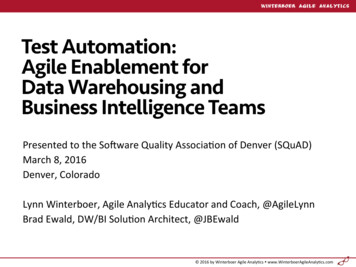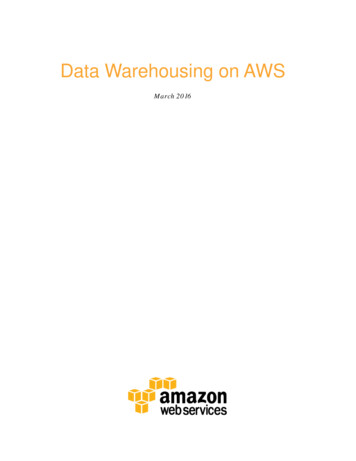
Transcription
Data Warehousing on AWSMarch 2016
Amazon Web Services – Data Warehousing on AWSMarch 2016 2016, Amazon Web Services, Inc. or its affiliates. All rights reserved.NoticesThis document is provided for informational purposes only. It represents AWS’scurrent product offerings and practices as of the date of issue of this document,which are subject to change without notice. Customers are responsible formaking their own independent assessment of the information in this documentand any use of AWS’s products or services, each of which is provided “as is”without warranty of any kind, whether express or implied. This document doesnot create any warranties, representations, contractual commitments, conditionsor assurances from AWS, its affiliates, suppliers or licensors. The responsibilitiesand liabilities of AWS to its customers are controlled by AWS agreements, andthis document is not part of, nor does it modify, any agreement between AWSand its customers.Page 2 of 26
Amazon Web Services – Data Warehousing on AWSMarch 2016ContentsAbstract4Introduction4Modern Analytics and Data Warehousing Architecture6Analytics ArchitectureData Warehouse Technology Options12Row-Oriented Databases12Column-Oriented Databases13Massively Parallel Processing Architectures15Amazon Redshift Deep Dive15Performance15Durability and Availability16Scalability and Elasticity16Interfaces17Security17Cost Model18Ideal Usage Patterns18Anti-Patterns19Migrating to Amazon RedshiftPage 3 of 26620One-Step Migration20Two-Step Migration20Tools for Database Migration21Designing Data Warehousing Workflows21Conclusion24Further Reading25
Amazon Web Services – Data Warehousing on AWSMarch 2016AbstractData engineers, data analysts, and developers in enterprises across the globe arelooking to migrate data warehousing to the cloud to increase performance andlower costs. This whitepaper discusses a modern approach to analytics and datawarehousing architecture, outlines services available on Amazon Web Services(AWS) to implement this architecture, and provides common design patterns tobuild data warehousing solutions using these services.IntroductionIn today’s world, data and analytics are indispensable to business. Almost alllarge enterprises have built data warehouses for reporting and analytics purposesusing the data from a variety of sources, including their own transactionprocessing systems and other databases.But building and running a data warehouse—a central repository of informationcoming from one or more data sources—has always been complicated andexpensive. Most data warehousing systems are complex to set up, cost millions ofdollars in upfront software and hardware expenses, and can take months inplanning, procurement, implementation, and deployment processes. After youhave made the initial investments and set your data warehouse up, you have tohire a team of database administrators to keep your queries running fast andprotect against data loss.Traditional data warehouses are also difficult to scale. When data volumes growor you want to make analytics and reports available to more users, you have tochoose between accepting slow query performance or investing time and effort onan expensive upgrade process. In fact, some IT teams discourage augmentingdata or adding queries to protect existing service-level agreements. Manyenterprises struggle with maintaining a healthy relationship with traditionaldatabase vendors. They are often forced to either upgrade hardware for amanaged system or enter a protracted negotiation cycle for an expired termlicense. When they reach the scaling limit on one data warehouse engine, they areforced to migrate to another engine from the same vendor with different SQLsemantics.Page 4 of 26
Amazon Web Services – Data Warehousing on AWSMarch 2016Amazon Redshift has changed how enterprises think about data warehousing bydramatically lowering the cost and effort associated with deploying datawarehouse systems without compromising on features and performance. AmazonRedshift is a fast, fully managed, petabyte-scale data warehousing solution thatmakes it simple and cost-effective to analyze large volumes of data using existingbusiness intelligence (BI) tools. With Amazon Redshift, you can get theperformance of columnar data warehousing engines that perform massivelyparallel processing (MPP) at a tenth of the cost. You can start small for 0.25 perhour with no commitments and scale to petabytes for 1,000 per terabyte peryear.Since launching in February 2013, Amazon Redshift has been one of fastestgrowing AWS services, with many thousands of customers across industries andcompany sizes. Enterprises such as NTT DOCOMO, FINRA, Johnson & Johnson,Hearst, Amgen, and NASDAQ have migrated to Amazon Redshift. As a result,Amazon Redshift ranked as a leader in the Forrester Wave: Enterprise DataWarehouse, Q4 2015 report. 1In this whitepaper, we provide you the information you need to take advantage ofthe strategic shift happening in the data warehousing space from on-premises tothe cloud:Page 5 of 26 Modern analytics architecture Data warehousing technology choices available within that architecture A deep dive on Amazon Redshift and its differentiating features A blueprint for building a complete data warehousing system on AWS withAmazon Redshift and other services Practical tips for migrating from other data warehousing solutions andtapping into our partner ecosystem
Amazon Web Services – Data Warehousing on AWSMarch 2016Modern Analytics and Data WarehousingArchitectureAgain, a data warehouse is a central repository of information coming from oneor more data sources. Data typically flows into a data warehouse fromtransactional systems and other relational databases, and typically includesstructured, semi-structured, and unstructured data. This data is processed,transformed, and ingested at a regular cadence. Users including data scientists,business analysts, and decision-makers access the data through BI tools, SQLclients, and spreadsheets.Why build a data warehouse at all—why not just run analytics queries directly onan online transaction processing (OLTP) database, where the transactions arerecorded? To answer the question, let’s look at the differences between datawarehouses and OLTP databases. Data warehouses are optimized for batchedwrite operations and reading high volumes of data, whereas OLTP databases areoptimized for continuous write operations and high volumes of small readoperations. In general, data warehouses employ denormalized schemas like theStar schema and Snowflake schema because of high data throughputrequirements, whereas OLTP databases employ highly normalized schemas,which are more suited for high transaction throughput requirements. The Starschema consists of a few large fact tables that reference a number of dimensiontables. The Snowflake schema, an extension of the Star schema, consists ofdimension tables that are normalized even further.To get the benefits of using a data warehouse managed as a separate data storewith your source OLTP or other source system, we recommend that you build anefficient data pipeline. Such a pipeline extracts the data from the source system,converts it into a schema suitable for data warehousing, and then loads it into thedata warehouse. In the next section, we discuss the building blocks of an analyticspipeline and the different AWS services you can use to architect the pipeline.Analytics ArchitectureAnalytics pipelines are designed to handle large volumes of incoming streams ofdata from heterogeneous sources such as databases, applications, and devices.Page 6 of 26
Amazon Web Services – Data Warehousing on AWSMarch 2016A typical analytics pipeline has the following stages:1. Collect data.2. Store the data.3. Process the data.4. Analyze and visualize the data.For an illustration, see Figure 1, following.Figure 1: Analytics PipelineData CollectionAt the data collection stage, consider that you probably have different types ofdata, such as transactional data, log data, streaming data, and Internet of Things(IoT) data. AWS provides solutions for data storage for each of these types ofdata.Transactional DataTransactional data, such as e-commerce purchase transactions and financialtransactions, is typically stored in relational database management systems(RDBMS) or NoSQL database systems. The choice of database solution dependson the use case and application characteristics. A NoSQL database is suitablewhen the data is not well-structured to fit into a defined schema, or when theschema changes very often. An RDBMS solution, on the other hand, is suitablewhen transactions happen across multiple table rows and the queries requirecomplex joins. Amazon DynamoDB is a fully managed NoSQL database servicethat can be used as an OLTP store for your applications. Amazon RDS allows youto implement a SQL-based relational database solution for your application.Page 7 of 26
Amazon Web Services – Data Warehousing on AWSMarch 2016Log DataReliably capturing system-generated logs will help you troubleshoot issues,conduct audits, and perform analytics using the information stored in the logs.Amazon Simple Storage Service (Amazon S3) is a popular storage solution fornontransactional data, such as log data, that is used for analytics. Because itprovides 11 9’s of durability (that is, 99.999999999 percent durability), AmazonS3 is also a popular archival solution.Streaming DataWeb applications, mobile devices, and many software applications and servicescan generate staggering amounts of streaming data—sometimes terabytes perhour—that need to be collected, stored, and processed continuously. 2 UsingAmazon Kinesis services, you can do that simply and at a low cost.IoT DataDevices and sensors around the world send messages continuously. Enterprisessee a growing need today to capture this data and derive intelligence from it.Using AWS IoT, connected devices interact easily and securely with the AWScloud. AWS IoT makes it easy to use AWS services like AWS Lambda, AmazonKinesis, Amazon S3, Amazon Machine Learning, and Amazon DynamoDB tobuild applications that gather, process, analyze, and act on IoT data, withouthaving to manage any infrastructure.Data ProcessingThe collection process provides data that potentially has useful information. Youcan analyze the extracted information for intelligence that will help you growyour business. This intelligence might, for example, tell you about your userbehavior and the relative popularity of your products. The best practice to gatherthis intelligence is to load your raw data into a data warehouse to perform furtheranalysis.To do so, there are two types of processing workflows, batch and real time. Themost common forms of processing, online analytic processing (OLAP) and OLTP,each use one of these types. Online analytic processing (OLAP) processing isgenerally batch-based. In contrast, OLTP systems are oriented towards real-timeprocessing and are generally not well-suited for batch-based processing. If youdecouple data processing from your OLTP system, you keep the data processingfrom affecting your OLTP workload.Page 8 of 26
Amazon Web Services – Data Warehousing on AWSMarch 2016First, let's look at what is involved in batch processing.Extract Transform Load (ETL)ETL is the process of pulling data from multiple sources to load into datawarehousing systems. ETL is normally a continuous ongoing process with a welldefined workflow. During this process, data is initially extracted from one ormore sources. The extracted data is then cleansed, enriched, transformed, andloaded into a data warehouse. Hadoop framework tools such as Apache Pig andApache Hive are commonly used in an ETL pipeline to perform transformationson large volumes of data.Extract Load Transform (ELT)ELT is a variant of ETL where the extracted data is loaded into the target systemfirst. Transformations are performed after the data is loaded into the datawarehouse. ELT typically works well when your target system is powerful enoughto handle transformations. Amazon Redshift is often used in ELT pipelinesbecause it is highly efficient in performing transformations.Online Analytical Processing (OLAP)OLAP systems store aggregated historical data in multidimensional schemas.Used widely in data mining, OLAP systems allow you to extract data and spottrends on multiple dimensions. Because it is optimized for fast joins, AmazonRedshift is often used to build OLAP systems.Now, let’s look at what’s involved in real-time processing of data.Real-Time ProcessingWe talked about streaming data earlier and mentioned Amazon Kinesis as asolution to capture and store streaming data. You can process this datasequentially and incrementally on a record-by-record basis or over sliding timewindows, and use the processed data for a wide variety of analytics includingcorrelations, aggregations, filtering, and sampling. This type of processing iscalled real-time processing. Information derived from real-time processing givescompanies visibility into many aspects of their business and customer activity—such as service usage (for metering or billing), server activity, website clicks, andgeolocation of devices, people, and physical goods—and enables them to respondpromptly to emerging situations. Real-time processing requires a highlyconcurrent and scalable processing layer.Page 9 of 26
Amazon Web Services – Data Warehousing on AWSMarch 2016To process streaming data in real time, you can use AWS Lambda. Lambda canprocess the data directly from AWS IoT or Amazon Kinesis Streams. Lambda letsyou run code without provisioning or managing servers.Amazon Kinesis Client Library (KCL) is another way to process data fromAmazon Kinesis Streams. KCL gives you more flexibility than AWS Lambda tobatch your incoming data for further processing. You can also use KCL to applyextensive transformations and customizations in your processing logic.Amaz
Amazon Web Services – Data Warehousing on AWS March 2016 Page 4 of 26 Abstract Data engineers, data analysts, and developers in enterprises across the globe are looking to migrate data warehousing to the cloud to increase performance and

